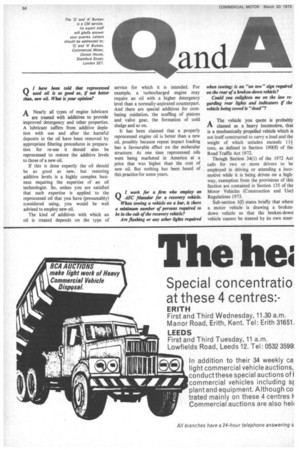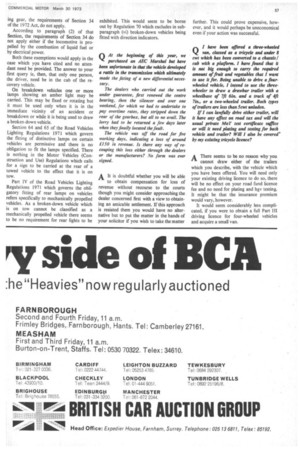Q I work for a firm who employ an AEC Matador
Page 56

Page 57

If you've noticed an error in this article please click here to report it so we can fix it.
for a recovery vehicle. When towing a vehicle on a bar, is there a minimum number of persons required to be in the cab of the recovery vehicle?
Are flashing or any other lights required when towing; is an "on tow" sign required on the rear of a broken-down vehicle?
Could you enlighten me on the law regarding rear lights and indicators if the vehicle being towed is "dead"?
AThe vehicle you quote is probably classed as a heavy locomotive, that is a mechanically propelled vehicle which is not itself constructed to carry a load and the weight of which unladen exceeds 111 tons, as defined in Section 190(8) of the Road Traffic Act 1972,
Though Section 34(1) of the 1972 Act calls for two or more drivers to be employed in driving or attending a locomotive while it is being driven on a highway, exemption from the provisions of this Section are contained in Section 135 of the Motor Vehicles (Construction and Use) Regulations 1973, Sub-section l(f) states briefly that where a motor vehicle is drawing a brokendown vehicle so that the broken-down vehicle cannot be steered by its own steer ing gear, the requirements of Section 34 of the 1972 Act, do not apply.
According to paragraph (2) of that Section, the requirements of Section 34 do not apply either if the locomotive is propelled by the combustion of liquid fuel or by electrical power.
Both these exemptions would apply in the case which you have cited and no attendant need be provided. The answer to your first query is, then, that only one person, the driver, need be in the cab of the recovery vehicle.
On breakdown vehicles one or more lamps showing an amber light may be carried. This may be fixed or rotating but it must be used only when it is in the immediate vicinity of an accident or breakdown or while it is being used to draw a broken-down vehicle.
Section 64 and 65 of the Road Vehicles Lighting Regulations 1971 which govern the fitting of distinctive lamps on certain vehicles are permissive and there is no obligation to fit the lamps specified. There is nothing in the Motor Vehicles (Construction and Use) Regulations which calls for a sign to be carried at the rear of a towed vehicle to the effect that it is on tow.
Part IV of the Road Vehicles Lighting Regulations 1971 which governs the obligatory fitting of rear lamps on vehicles refers specifically to mechanically propelled vehicles. As a broken-down vehicle which is on tow cannot be classified as a mechanically propelled vehicle there seems to be no requirement for rear lights to be exhibited. This would seem to be borne out by Regulation 70 which excludes in subparagraph (vi) broken-down vehicles being fitted with direction indicators.










































































































